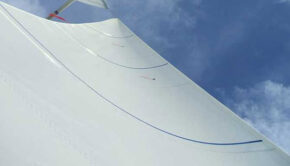Sailing Lulls: What’s the Best Response?
Published on November 8th, 2021
While variable winds can be found anywhere, the best inland lake sailors are like Houdini with sailing gloves. True magicians. For the next time when light winds are testing your patience, here’s some tips from the inland masters at SailZing:
Lulls are inevitable. The instinctive response is to ease your sail and bear off to maintain boat speed and react to what you’re seeing in your sail telltales. However, this instinctive response is wrong. In this post, we summarize the expert advice for sailing lulls.
First let’s remember what happens to the apparent wind when you sail into a lull. Apparent wind is the combination of the true wind and the “boat wind” – the headwind wind created as your boat moves forward. In a lull, the true wind decreases quickly, but the boat wind does not decrease until the boat slows down.
Thus, the apparent wind decreases and initially moves forward when the lull appears. As your boat coasts ahead and slows, the boat wind gradually decreases and the apparent wind moves back to roughly its original direction.
In short, when you sail into a lull, you get an apparent wind header, sometimes called a velocity header. Your luff telltales may flutter and you feel you are pinching. However, this header is short-lived: the header largely goes away as the boat slows down.
VMG in a lull
Let’s look the boat’s velocity made good (VMG) during a lull. The key concept is that as the wind velocity changes, you want to get to the new target boat speed quickly to maximize VMG. In a lull, your target boat speed decreases. So, perhaps counterintuitively, your goal is to bleed excess speed to get to the new target. For background on VMG, see our post Velocity Made Good (VMG) – Definition and Application, especially the section on target boat speeds.
Sailing Lulls Classic Technique
Now let’s explain the basis for classic lull response: pinch through the lulls, ease your sails slightly, and get your weight in quickly to maintain constant heel angle. Let’s talk about each of these. – Full report









 We’ll keep your information safe.
We’ll keep your information safe.